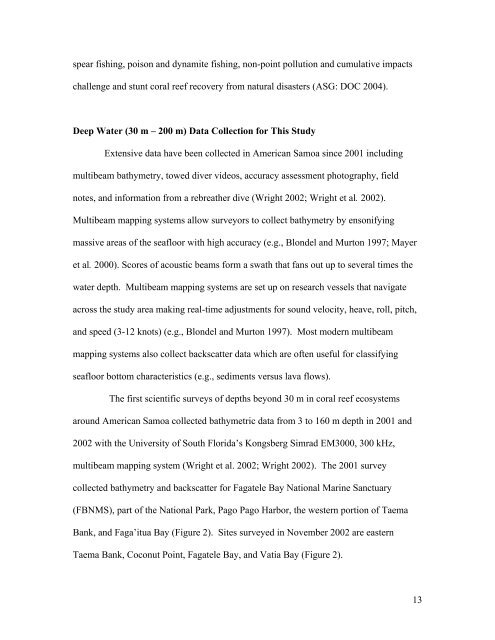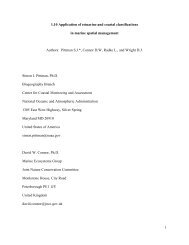A Benthic Terrain Classification Scheme for American Samoa
A Benthic Terrain Classification Scheme for American Samoa
A Benthic Terrain Classification Scheme for American Samoa
Create successful ePaper yourself
Turn your PDF publications into a flip-book with our unique Google optimized e-Paper software.
spear fishing, poison and dynamite fishing, non-point pollution and cumulative impacts<br />
challenge and stunt coral reef recovery from natural disasters (ASG: DOC 2004).<br />
Deep Water (30 m – 200 m) Data Collection <strong>for</strong> This Study<br />
Extensive data have been collected in <strong>American</strong> <strong>Samoa</strong> since 2001 including<br />
multibeam bathymetry, towed diver videos, accuracy assessment photography, field<br />
notes, and in<strong>for</strong>mation from a rebreather dive (Wright 2002; Wright et al. 2002).<br />
Multibeam mapping systems allow surveyors to collect bathymetry by ensonifying<br />
massive areas of the seafloor with high accuracy (e.g., Blondel and Murton 1997; Mayer<br />
et al. 2000). Scores of acoustic beams <strong>for</strong>m a swath that fans out up to several times the<br />
water depth. Multibeam mapping systems are set up on research vessels that navigate<br />
across the study area making real-time adjustments <strong>for</strong> sound velocity, heave, roll, pitch,<br />
and speed (3-12 knots) (e.g., Blondel and Murton 1997). Most modern multibeam<br />
mapping systems also collect backscatter data which are often useful <strong>for</strong> classifying<br />
seafloor bottom characteristics (e.g., sediments versus lava flows).<br />
The first scientific surveys of depths beyond 30 m in coral reef ecosystems<br />
around <strong>American</strong> <strong>Samoa</strong> collected bathymetric data from 3 to 160 m depth in 2001 and<br />
2002 with the University of South Florida’s Kongsberg Simrad EM3000, 300 kHz,<br />
multibeam mapping system (Wright et al. 2002; Wright 2002). The 2001 survey<br />
collected bathymetry and backscatter <strong>for</strong> Fagatele Bay National Marine Sanctuary<br />
(FBNMS), part of the National Park, Pago Pago Harbor, the western portion of Taema<br />
Bank, and Faga’itua Bay (Figure 2). Sites surveyed in November 2002 are eastern<br />
Taema Bank, Coconut Point, Fagatele Bay, and Vatia Bay (Figure 2).<br />
13
















